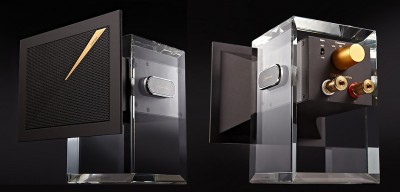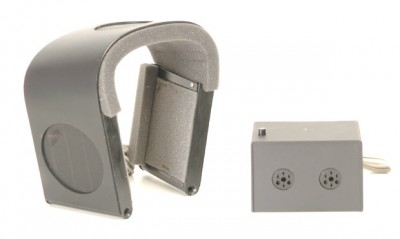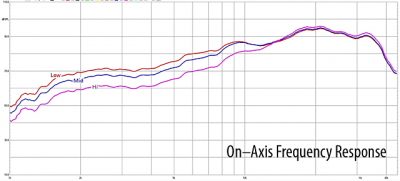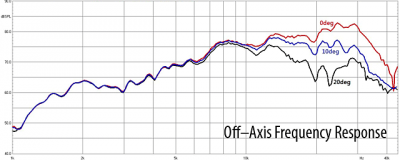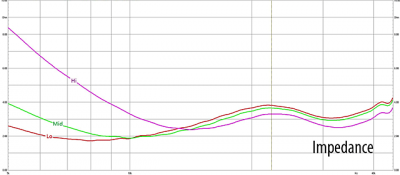Air Apparent
Supertweeters have gone in and out of vogue over the years, with moving coils, ribbons, quasi–ribbons and piezos to choose from. I’ve had some fun with Tannoy’s radiused hockey puck, and have had the less than exciting experience of hearing Murata’s outboard tweets at trade shows. My impression, intoned with more than a touch of sarcasm, has always been “That’s nice, dear.” After all, with advances in loudspeaker technology keeping pace with ultrawideband digital sources, it’s not that difficult to find loudspeakers with upper -3 dB points in excess of 30 kHz. Still and all, the majority of available speakers hew to the traditional view, where 20 kiloHertz is the upper limit of hearing so, “Why bother with ultrasonics?”
This is the second time I’m wading into the boggy mire of That Which Is Beyond Orthodoxy. It would seem I enjoy making trouble for myself. The last time, it was the “sound” of USB cables. This time, it’s ENIGMAcoustics Sopranino electret supertweeter, a high style widget that really serves the purpose well.
What’s the purpose of a supertweeter, you may ask? One application would be to extend the high frequency (HF) response of a system that rolls off at the high end. The other would be to extend a system that provides little or no ultrasonic energy. The former makes sense; adding that which is “missing,” with single-driver speakers coming to mind. The latter is more controversial; adding that which seemingly serves no purpose.
I started my exploration of these little fellers by taking them out of their veneered box, itself in a corrugated containerboard shipping box with closed cell foam spacers. Inside their wooden chest, they are snuggled in black velveteen–lined conformal foam. The pair arrived with white editor’s gloves, the better to prevent besmirching their transparent glass base. The actual transducer assembly is fastened to its mitered ½” thick, 7″ tall stand at four points via what appears to be compliant grommets, so the supertweets are decoupled a bit from their supports.
I prepared a set of 26″ Monster Cable bare wire jumpers which I used for most of my tests. Go ahead and sneer, I certainly didn’t feel guilty about hacking some up for this application. Sopraninos are designed to be paralleled to existing speakers, which I did. Both my B&W 685s and a set of loaner Bryston Mini-Ts are bi–wireable so, with the jumpers in place, I used the upper binding posts for the supertweets while the amp was hooked to the lower connectors. The Sopranino’s binding posts are by WBT, while internal and high-voltage wiring is a mix of Litz and proprietary. More on the high voltage aspect in a bit…
About the transducer itself; The Sopranino is a pre–polarized electret. To understand that technology, think of the roll of plastic food wrap you probably have in the kitchen drawer. Whenever you draw it off of its roll, it clings to everything, making it a bit challenging to position it on the container that needs it. The clinging is from a static charge that is built into the plastic, usually PVC, combined with additional charge generated when you separate the sheet from the roll. That clingy plastic film is a form of electret, a material with a permanent static charge built in. In the case of the Sopraninos, the plastic is tetrafluoroethylene polymer or PTFE, the stuff coating inexpensive “nonstick” cookware. For this application, PTFE is fabricated to create a thin, strong sheet. ENIGMAcoustics specs the thickness as “…a few microns,” which translates into very light weight.
For audio transducers, electrostatic technology is more common than electrets†. You probably know of Stax and their high end electrostatic headphones. I once owned a pair of silver Jeklin Floats, my first truly high fidelity cans.
They were really fun but exhibited a nasty tendency to snap, crackle, and pop like a bowl of newly wetted breakfast cereal. The noise was an indirect result of the very high voltages needed for electrostats to operate. Note the power supply in the above illustration. Sopraninos require no power supply. They’re passive, and use an internal step–up transformer to derive the voltage they require.
Wei Chang, front man for ENIGMAcoustics, told me the permanently-polarized electret diaphragm is approximately 6 mm from the front grille, positioned immediately behind a screen of protective polypropylene cloth. I needed that positional information to dial in the front/back position relative to the mains for time alignment. For that diaphragm, the key design challenge, he told me, was to create a material able to hold as many electrons as possible and “keep them there for as long as science and the laws of nature allow. Hundreds of formulas were concocted and experimented with during years of R&D before we came up with the current patented commercial version.”
Chang also mentioned other aspects of the design process: “We changed and patented front and back stator plates…, replaced spacer materials, completely re–designed the driver circuits, introduced a specialized custom (step–up) transformer, and added a protection circuit, and only then did we proceed to begin the painstaking task of rigorous testing to ensure optimal performance and reliability.”
One peculiarity of the design that I needed help with is the horn and how it’s loaded. Sopranino’s horn is “backwards” from normal audio implementations, with the transducer at the mouth or front instead at the throat in the back. As with all horns, their employment controls directivity and improves efficiency but traditionally, it does that by loading the throat or narrow end. “When (applied) to super tweeters, we found directivity more of an asset instead of a liability,” since it avoids side wall reflections as usually seen with traditional dome tweeters. Chang confessed that, “initially, a standard exponential flare type horn design, with the assistance of acoustic foam, was used to house the dipole driver. However, due to limitations of material and space, not all back wave energy could be absorbed completely. Reflections from the housing were still able to penetrate through the front diaphragm. However minor, the penetrated energy still affected the dispersion of front waves. This is why the horn’s (design) … was altered in order to modify the front dispersion pattern.”
Sopraninos are designed with a nominal sensitivity of “90 dB at 2.83 V input” and were compatible with the three different loudspeakers I tried. On the back is a small GAIN toggle, with zero and -3 dB positions. The factory recommends the 0 dB setting but, in all cases, I and other listeners preferred -3 for a better match.
The back also holds a three position rotary switch to control the resonant frequency of an internal, 2nd order LC series high pass filter. The crossover is housed in a separate compartment from the transducer, and has turnover choices of 8, 10, or 12 kHz. Again, I always preferred the most conservative setting, crossing over at 12 kHz. As to impedance, the minimum of 3 Ω is at 12 kHz.
Enough with the speeds and feeds, and on with the subjective evaluation. First, I listened with several digital sources, and with files ranging from 44.1 to 192 kHz sampling rate. Without exception, the audible improvement provided by the supertweeters was minimal at 44.1 or 48k, involving at 88.2 or 96k and, as they say in the Boston Audio Society, wicked awesome at 4x sample rates. From this, I inferred that the presence of ultrasonics in the music, however slight, provided additional information for my brain to decode. [1]
In all three instances, Sopraninos didn’t add “air” as I had expected, they moved the virtual walls of the soundstage out to the left and right, while raising the ceiling a bit. That’s not the whole picture in that I also heard the soundstage expand. Rather, I heard soundstage size cues where none had been before. With some carefully recorded, high rez material, I could sense the room itself. With some recordings, placement on the stage was better defined as well. Without Sopranino, the recording conveyed a more conventional soundstage.
For fun, I also took the supertweets and my B&W bookshelfs to the Pavek Museum of Broadcasting for a meeting of the Audio Society of Minnesota. Amplification was by Audio Research and the DAC was a Mytek Stereo192-DSD Mastering Edition. The response by the group was the same as mine. When asked what they heard with the product in circuit, the common response was a “wider” motion with the hands. Participants young and old mentioned the improved soundstage and expansion of perceived ambience.
In addition to my inexpensive 685s and the moderately priced Mini-Ts mentioned earlier, I made a field trip to the wilds of Maple Grove for a visit to Analog Audio of MN. Their rig du jour consisted of:
Speakers, Amplification & Wiring:
Rockport Technologies Avior (3 dB down at 30 kHz)
VTL MB-450 Series III monoblocks
TL7.5 Series III Reference preamp
Synergistic Research Galileo System cabling for the mains
Prana Wire Nataraja Series for the supertweeters
Digital Source:
Vitus Audio RD-100 DAC
MBP running Amarra Symphony
Analog Source:
Brinkmann Oasis with a Dynavector DRT XV-1s
Paul Blizel, the proprietor of Analog Audio, and I listened to a bunch of files but only one analog recording, the Analog Productions reissue of the Fritz Reiner Schaherezade. With either the analog or digital sources, the supertweeters added a touch of subjective soundstage expansion, but the Sopraninos were not a must–have accessory with the Rockports. In Paul’s room, with his gear, the effect was minimal at best.
For a time, I had a pair of Bryston Mini-Ts small towers as mentioned earlier. With these speakers, I could never quite find a physical placement that “did it” for me. The whole system never jelled the way it did with my B&Ws. Though the price mismatch was laughable, in my room with my little speakers, the Sopranino addition was magical. I’m not surprised that ENIGMAcoustics’ own Mythology M1 incorporates a bookshelf–sized main with their supertweeter outboard.
There seem to be only two factors weighing against this product; the cost is nontrivial though not crazy, and they seem to work well with particular speakers more than others. So, if you have a traditional set of speakers that roll off past 18 to 20 kHz, and you’re looking to greatly improve your listening experience without a second mortgage, then wrangle an in–system test to gauge how well they mesh with your rig and room. Bearing that caveat in mind, I’d rank them as highly recommended.
† Electret has a more common use in audio, as the diaphragm material for condenser microphones, the chosen pickup of classical recordists. “Condensers” comes in two broad varieties, notwithstanding the size and shape of the capsule assembly. One requires a bias voltage applied to the capsule, which is supplied via either an integrated power supply or via external “T” or “phantom” power over the same XLR connection that transmits the audio signal. The other is to use pre–polarized diaphragm material, an electret. The latter requires no power supply, at least for bias voltage. My fave example of the pre–polarized electret variety is DPA’s d:dicate 4000 series of microphones. By the way, all condenser mics need active circuitry to provide current–to–voltage conversion but, for that, a small battery will suffice.
[1] Inaudible High-Frequency Sounds Affect Brain Activity: Hypersonic Effect
T. Oohashi , E. Nishina , M. Honda , et al
Journal of Neurophysiology; Published 1 June 2000, Vol. 83 no. 3548-3558
Contact
ENIGMAcoustics, Irvine CA
www.ENIGMAcoustics.com
$3,690/pair MSRP
$600/pair, optional height-adjustable stands [not tested]
Music in heavy rotation during this review
- Darcy James Argue’s Secret Society — Brooklyn Babylon (2013 New Amsterdam). Exciting, contemporary Big Band
- Fanfarlo — Rooms Filled With Light (2012 Atlantic/Canvasback Music). Pure pop for spring or summertime
- Little Dragon — Ritual Union (2011 P&C Peacefrog). Well crafted, engaging synthpop starting with the addictive & danceable eponymous first track
- Andrew Hadro — For Us, The Living (2014 Tone Rogue). Hadro’s horn leads this quartet in modern, straight ahead jazz that’s thoroughly enjoyable
- Pixies — Indie Cindy (2014 Pixiesmusic). Still rockin’ as only the Pixies can
- Gregory Porter — Liquid Spirit (2013 Blue Note/Universal). Award–winning lyric jazz from that distinctive voice
- Bryan Simpson — The Whistles & the Bells (2014 Poke the Bear). Rockin’ good Americana from former Cadillac Sky frontman Bryan Simpson
Additional gear used for this review
Sources: Amarra Symphony w/iRC, iTunes
Cabling: Soundstring GEN II Beta 2-22S, VUE Digital VU-3, Wireworld Starlight 7, ANTICABLE Level 3
Conversion: Mytek Stereo192-DSD Mastering Edition, Calyx DAC 24/192
Amplification: Bryston 3B, SPL Phonitor (factory mod’d)
Cans: Audeze LCD-3, Etymotic ER•4PT
Speakers: Bowers & Wilkins 685, IsoAcoustics ISOL8R155, Sanus Foundations Steel
Power: Soundstring GEN II Digimax-18
